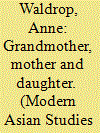|
|
|
Sort Order |
|
|
|
Items / Page
|
|
|
|
|
|
|
| Srl | Item |
| 1 |
ID:
119706


|
|
|
|
|
| Publication |
2013.
|
| Summary/Abstract |
Desiring to "engender" the written history of the Communist Party of India (CPI) and the movements it led or initiated, the author looks at the first generation of middle-class women who became communists in colonial Bengal in the period 1939 to 1948. Judging that much of the available printed and archival source material inadequately describes the role of women in the CPI, the author interviewed many of the surviving women CPI recruits and studied their printed memoirs. She examines in particular two organizations that were established in the late 1930s and early 1940s, namely, the Chhatri Sangha (Girl Students' Association) and the Mahila Atma Raksha Samity (Women's Self-Defense Association). The author contends that the recruiting and mobilizing strategies of the CPI-while focused primarily on class-also had important consequences for gender relations: many middle-class women found themselves transgressing the narrowly constructed norms of propriety and mixing with women of lower classes and working in public spaces together with men in ways the existing nationalist feminisms/nationalist conceptions of women's public activism had not made available. The author concludes that these revelations show the need to rethink stereotypes about the communist women, stereotypes built from the experiences of new generations of feminists in the 1960s and 1970s, but which seem not to have been as rigidly created or enforced in the 1940s as they were later on.
|
|
|
|
|
|
|
|
|
|
|
|
|
|
|
|
| 2 |
ID:
112481


|
|
|
|
|
| Publication |
2012.
|
| Summary/Abstract |
Covering one hundred years, this paper recounts the life stories of three generations of middle-class women of the New Delhi-based Kapoor family. By taking the methodological view that individuals born approximately at the same time, within the same class segment, and at the same cultural place will be shaped by the same historical structures so that their lives to some extent are synchronized into a gendered, generational experience, these three life stories are viewed as voices that reflect their respective generational class segments. In view of this, the paper uses the three life stories to discuss changes in women's agency within the urban, educated, upper middle-class. Agency is here understood as control over resources, and it is argued that in order to understand changes in women's agency, one should take into account the impact of both social, economic structures and cultural ideologies. When analysing the three life stories, the overall finding is that the granddaughter has had more control over her own life than her mother and grandmother. However, by acknowledging that cultural ideologies and social economic structures are not always synchronized, a nuanced and many-dimensional picture of twists and turns in these middle-class women's degree and type of agency over time emerges.
|
|
|
|
|
|
|
|
|
|
|
|
|
|
|
|
|
|
|
|
|